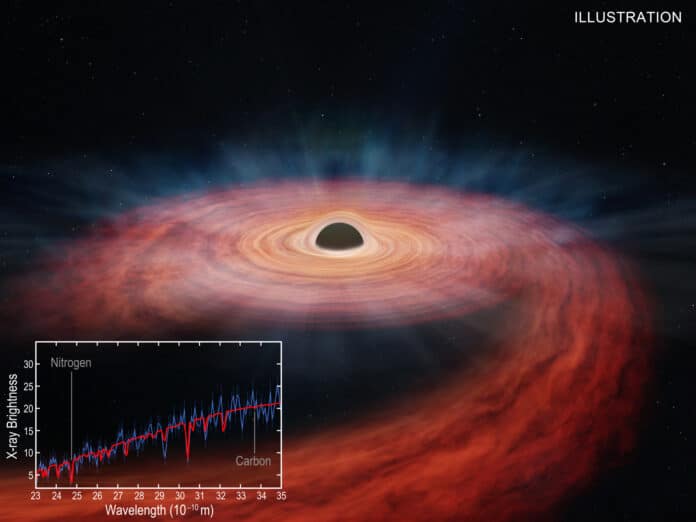NASA’s Chandra X-ray Observatory and ESA’s XMM-Newton examined the amount of nitrogen and carbon close to a black hole known to have ripped apart a star. According to astronomers, these elements were produced inside the star before it was shattered as it approached the black hole.
“We can determine what kind of star perished by looking at the elements left behind,” astronomers noted.
Such events are generally known as ‘tidal disruption events,’ where the gravitational forces from a massive black hole destroy a star. This event, called ASASSN-14li, stands out for several reasons.
ASASSN-14li is one of the nearest tidal disruption events (TDE) ever discovered. Because of this proximity, ASASSN-14li has provided extraordinary detail about the destroyed star.
Astronomers used new theoretical models to make improved estimates of the amount of nitrogen and carbon around the black hole. The team’s discovery of a nitrogen-to-carbon ratio suggests that the material came from the interior of a dying star about three times as massive as the Sun.
It suggests that the star in ASASSN-14li was one of the most massive astronomers have seen ripped apart by a black hole.
Co-author Enrico Ramirez-Ruiz of the University of California, Santa Cruz, said, “ASASSN-14li is exciting because one of the hardest things with tidal disruptions is being able to measure the mass of the unlucky star, as we have done here.”
“Observing the destruction of a massive star by a supermassive black hole is spellbinding because more massive stars are expected to be significantly less common than lower-mass stars.”
What the ASASSN-14li result suggests for future research is another fascinating part of the result. In the star cluster that houses the supermassive black hole at the heart of our galaxy, astronomers have observed stars of a moderate mass similar to ASASSN-14li’s. Astronomers may therefore be able to detect the presence of star clusters around supermassive black holes in farther away galaxies by being able to estimate the stellar masses of tidally shattered stars.
Scientists noted, “Until this study, there was a strong possibility that the elements observed in X-rays might have come from gas released in previous eruptions from the supermassive black hole. However, the pattern of elements analyzed here appears to have come from a single star.”
Journal Reference:
- Jon M. Miller, Brenna Mockler, et al. Evidence of a Massive Stellar Disruption in the X-Ray Spectrum of ASASSN-14li. The Astrophysical Journal Letters. DOI: 10.3847/2041-8213/ace03c
